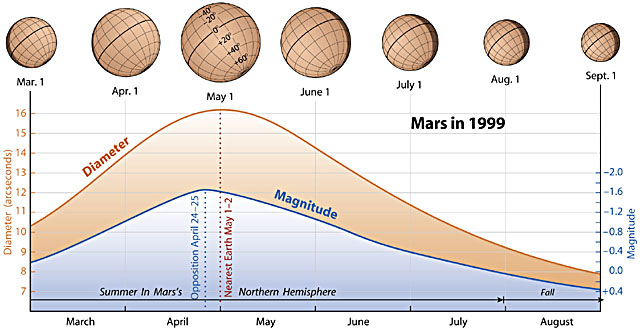
Observing prospects for Mars: its visual magnitude, size, orientation, and phase throughout the 1999 apparition. Chart taken from: http://www.skypub.com

For a more basic understanding
of Mars, we can turn to Earth-based observations. Using the naked
eye and telescopes, it is easy to spot and track Mars as it moves across
our night sky. This Spring has been pretty good for observing Mars.
The main reason for that is that this April on the twenty-fourth Mars was
at opposition. Opposition is when a superior planet is in the part of the
sky that is opposite the sun. When Mars is at opposition it is prime time
for viewing. Unfortunately this year was not a favorable opposition. A
favorable opposition is when Mars appears the biggest. This happens for
two reasons: one because it is at opposition and the other because it is
in the perihelion of its elliptical orbit. Even though Mars was at normal
opposition this Spring it still measured a total of 16.2 arcsecs across
the sky at itís biggest point on April 24.
This quarter we studied Marsí path in the night
sky. On the weekend of opposition Dan made observations of Marsí path starting
at 10:00 P.M. and continuing to record Mars' position in the sky every
half-hour. Dan did this for three nights in a row on Friday, Saturday (opposition),
and Sunday.
Rich used the Freeman Starry
Night program to record both the hourly path of Mars on opposition and
the daily change in the path of Mars at midnight. With all of these observations
together we could figure out where Mars was heading (barring retrograde
motion which did not effect this spring). Rich also observed Mars
as compared to the rest of the background stars. Nightly Mars traveled
westward as it rose and set in the sky. One of the main things we
noticed was that Mars never strayed too far from Spica. Sometimes
they appeared to be traveling in tandem. It was always easy to find
Mars because we used the tricks we learned earlier this quarter about finding
the Big Dipper and then ďarc to Arcturus and straight on to Spica.Ē
The daily change of Marsí position in the sky was similar to its nightly
path. On 3/24, a month before opposition, Mars was in the southeastern
part of the sky at midnight but by 5/5 the position of Mars at midnight
was almost directly south. We viewed Mars through the big telescope at
the Goldendale observatory, but because of atmospheric conditions on Earth,
we couldnít distinguish any detail on Marsí surface. It just looked
like a blurry red circle.
That blurry red circle has
managed to capture the imaginations and fears of people throughout history.
It is interesting to think that less than a century ago, it was commonly
accepted that an advanced civilization existed on Mars. Now we have
discovered a great deal about the Red Planet, and are learning more all
the time. Who knows, maybe in another 100 years, an advanced civilization
will exist on Mars: ours.